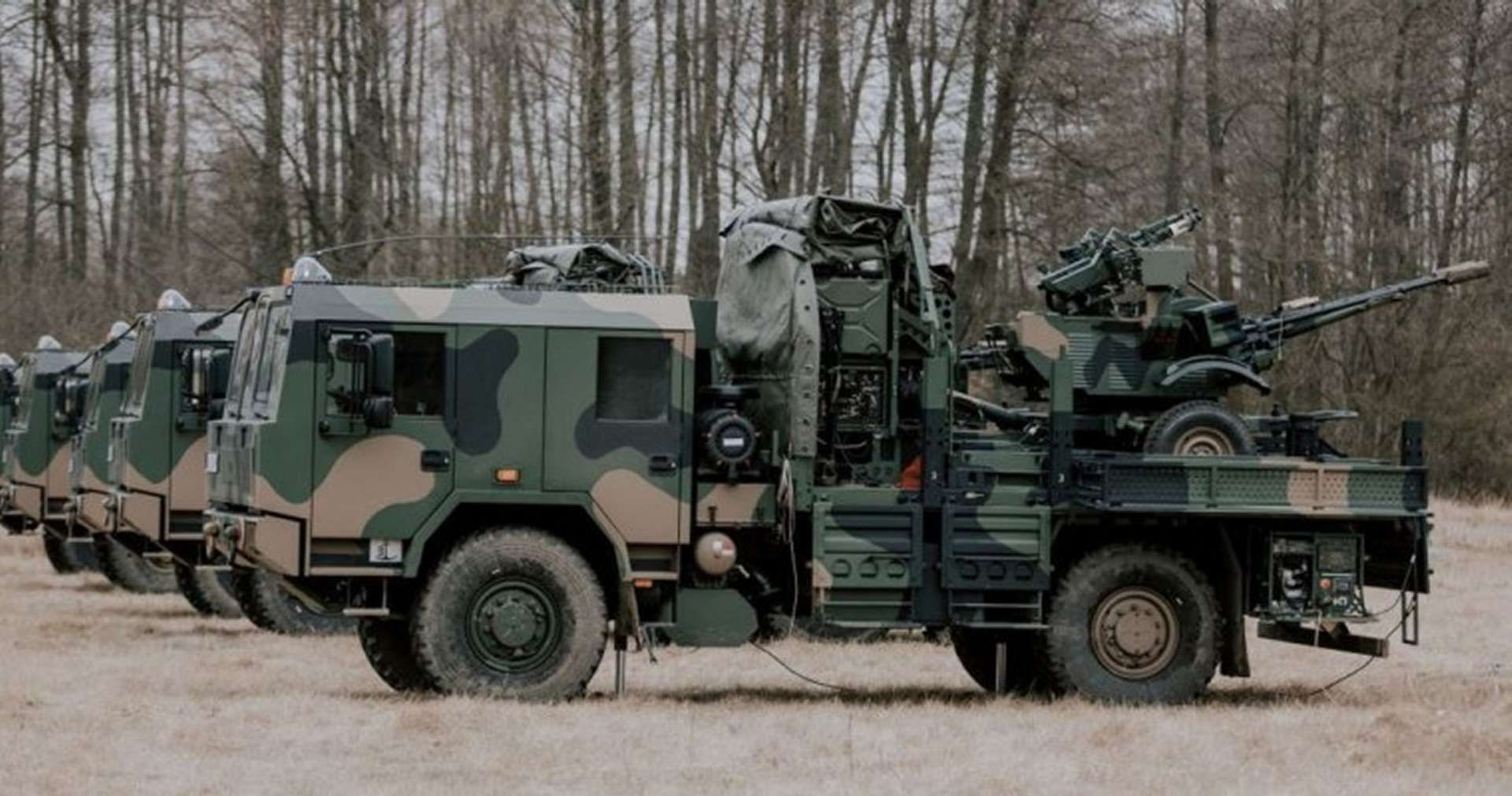Breaking News
MSPO 2024: PGZ's PSR-A Pilica Very Short Range Air Defense System emerges as key asset in Poland's air defense strategy.
At the 32nd International Defence Industry Exhibition (MSPO 2024), held in Poland from September 3 to 6, 2024, Polska Grupa Zbrojeniowa (PGZ SA), a state-owned holding company overseeing various Polish defense industry firms, presented its PSR-A Pilica, a Very Short Range Air Defense (VSHORAD) system engineered to engage low-flying air targets and lightly armored ground and surface targets. The system is capable of operating from stationary positions under diverse weather conditions and at any time of day, with provisions for remote target tracking.
Follow Army Recognition on Google News at this link

The Pilica Fire Unit can be mounted on an Artillery Tractor (AT) and is designed to function either independently or as part of a PSR-A Pilica battery, which provides automated and synchronized protection around strategic sites. (Picture source: Army Recognition)
The Pilica Fire Unit can be mounted on an Artillery Tractor (AT) and has the capacity to fire directly from the AT deck. It is designed to function either independently or as part of a PSR-A Pilica battery, which provides automated and synchronized protection around strategic sites. The unit can engage air targets using PPZR GROM or PIORUN missiles and 23mm ammunition designed for the 2A14 gun, with projectile options including high-explosive incendiary (OFZT), armor-piercing incendiary tracer (BZT), Armour Piercing Discarding Sabot with Tracer (APDS-T), and Frangible Armour Piercing Discarding Sabot with Tracer (FAPDS-T). The same 23mm cartridges are employed for targeting ground and surface threats.
The development of the PSR-A Pilica system began in 2006 at the Military University of Technology in Poland. Between 2010 and 2013, the project received co-financing from the National Centre for Research and Development and was managed by a consortium consisting of the Military University of Technology, Zakłady Mechaniczne Tarnów, and Bumar-Labedy. The system's contractor is the PGZ-Pilica consortium, which includes PGZ companies such as PIT-Radwar, PCO, and Zakłady Mechaniczne Tarnów. Internal testing of the system was completed in 2015.
A contract was signed in November 2016, valued at PLN 746.16 million (€174.500.708,40), for the delivery of six PSR-A Pilica systems, each consisting of six command posts, 36 fire units, six radar stations, and 60 support vehicles. In 2018, an annex to the contract initiated serial production. In 2019 and 2020, field exercises were conducted to evaluate the system's operational effectiveness. By October 2020, the PSR-A Pilica had successfully passed its delivery and acceptance tests, clearing the way for deployment to the Polish Armed Forces.

A contract was signed in November 2016, valued at €174.500.708, for the delivery of six PSR-A Pilica systems, each consisting of six command posts, 36 fire units, six radar stations, and 60 support vehicles. (Picture source: Polish MoD)
The first prototype of the six ordered units was delivered to the Polish Armed Forces in December 2020, where it was assigned to the 37th Air Defense Missile Squadron. The system's primary role is to provide airbase defense at low altitudes, supplementing existing missile systems. The first serial production unit was commissioned in March 2022, with subsequent deliveries completed by late 2022 and 2023.
The PSR-A Pilica is a Very Short Range Air Defense (VSHORAD) system forming the lowest tier of Poland’s air defense network. It is designed to counter unmanned aerial vehicles, helicopters, airplanes, and cruise missiles at ranges of up to 6,500 meters, and to offer localized protection for critical areas and assets. Its main armament is the ZUR-23-2SP Jodek missile and artillery set, which includes a double-barrel anti-aircraft gun with a theoretical rate of fire of 2,000 rounds per minute and an effective range of up to 3,000 meters. This armament is a modification of the 23mm ZU-23-2 gun, coupled with two PPZR GROM or PIORUN missile launchers, with ranges of up to 6.5 kilometers.
Each PSR-A Pilica battery comprises six fire units, each equipped with the ZUR-23-2SP Jodek set. Each unit has a GOS-1 optoelectronic head that features a thermal imaging camera, a TV camera, and a laser rangefinder, enabling independent operation in emergency situations. The system uses the KMW-1 Teja thermal imaging camera, produced by PCO. Additionally, the battery includes an automated command post mounted on a Jelcz 442.32 truck chassis, a three-coordinate radar (SRL-97) based on the IAI ELM-2106NG ADSR-3D Tactical Air Defense Radar by Israel Aerospace Industries, six artillery transport vehicles, two transport vehicles, and two ammunition vehicles, all using the Jelcz 442.32 chassis. The fire unit is also capable of engaging targets from the transport vehicle platform.

The Pilica Fire Unit can be mounted on an Artillery Tractor (AT), such as the Jelcz 442.32 4x4 military truck. (Picture source: PGZ)
The weapon control system is automated and includes a computerized guidance system that functions semi-automatically, engaging targets after operator confirmation. This system is integrated with a tracking system and an Identification Friend or Foe (IFF) system, which can automatically halt firing if the target is identified as friendly. The PSR-A Pilica also offers remote operation capability and has a manual operation mode for use during power failures.
The system's optoelectronic head, operating in both day and night modes, works independently of the main armament for observation, detection, and identification of targets. It serves as a component of the guidance system and provides data for the entire defense system. Each unit is also equipped with a laser warning receiver to enhance its situational awareness.
An agreement signed on October 4, 2022, outlines plans for an upgraded version of the system, known as "Pilica+." The enhanced configuration will include CAMM short-range missile launchers, Bystra radars, programmable ammunition, and systems designed to counter mini-class unmanned aerial vehicles. The contract covers the development of 21 systems, including upgrades of existing units to the new standard. The first enhanced "Pilica+" units are expected to be delivered in 2024.

Each PSR-A Pilica battery comprises six fire units, each equipped with the ZUR-23-2SP Jodek set. Each unit has a GOS-1 optoelectronic head that features a thermal imaging camera, a TV camera, and a laser rangefinder, enabling independent operation in emergency situations. (Picture source: Polish MoD)


























